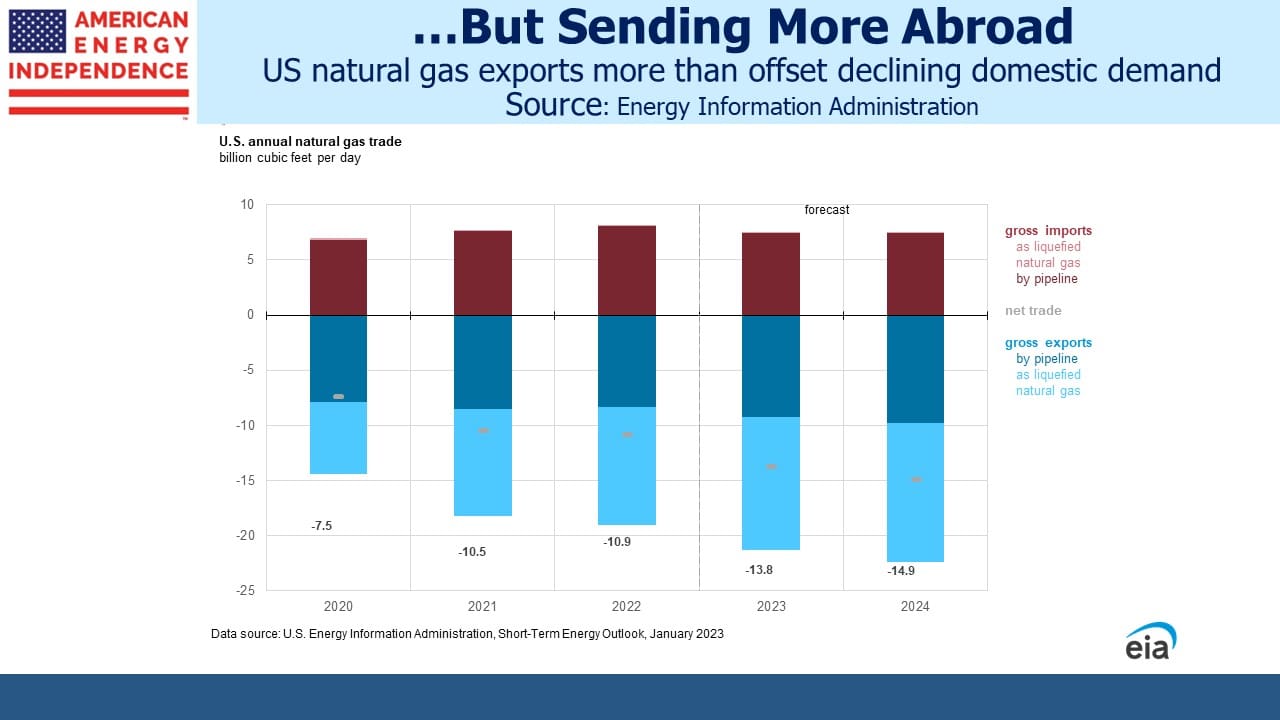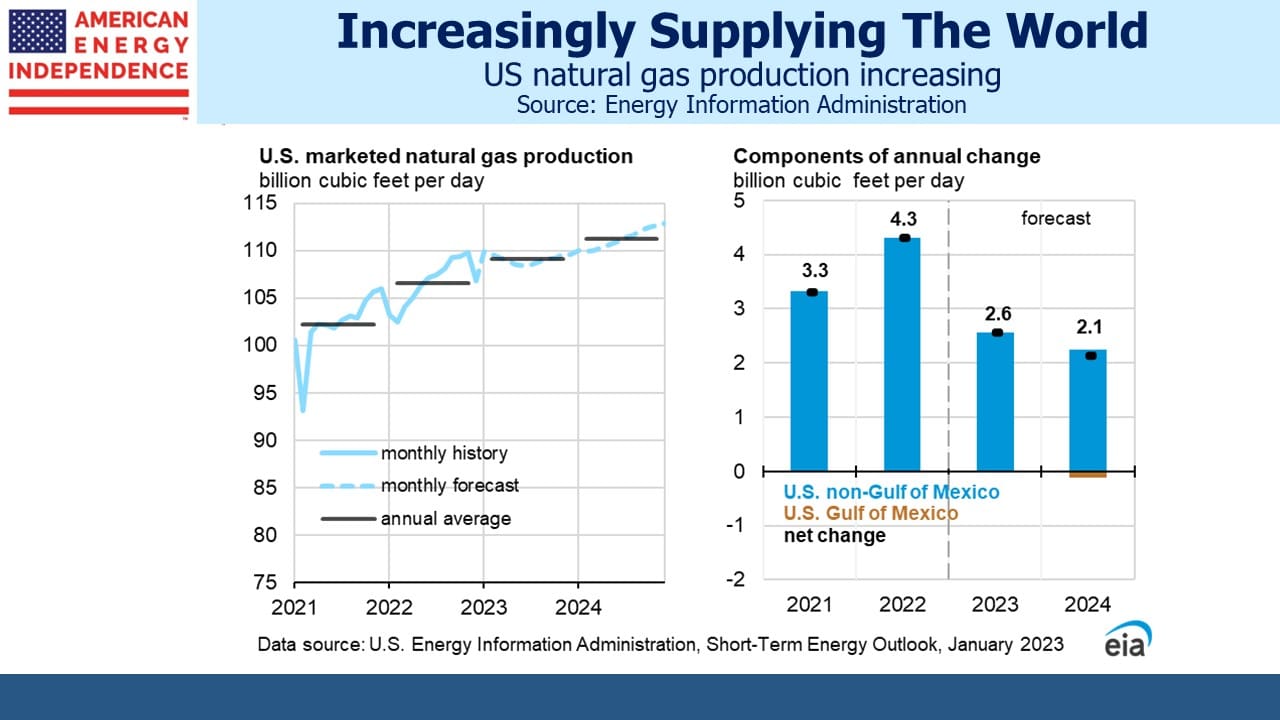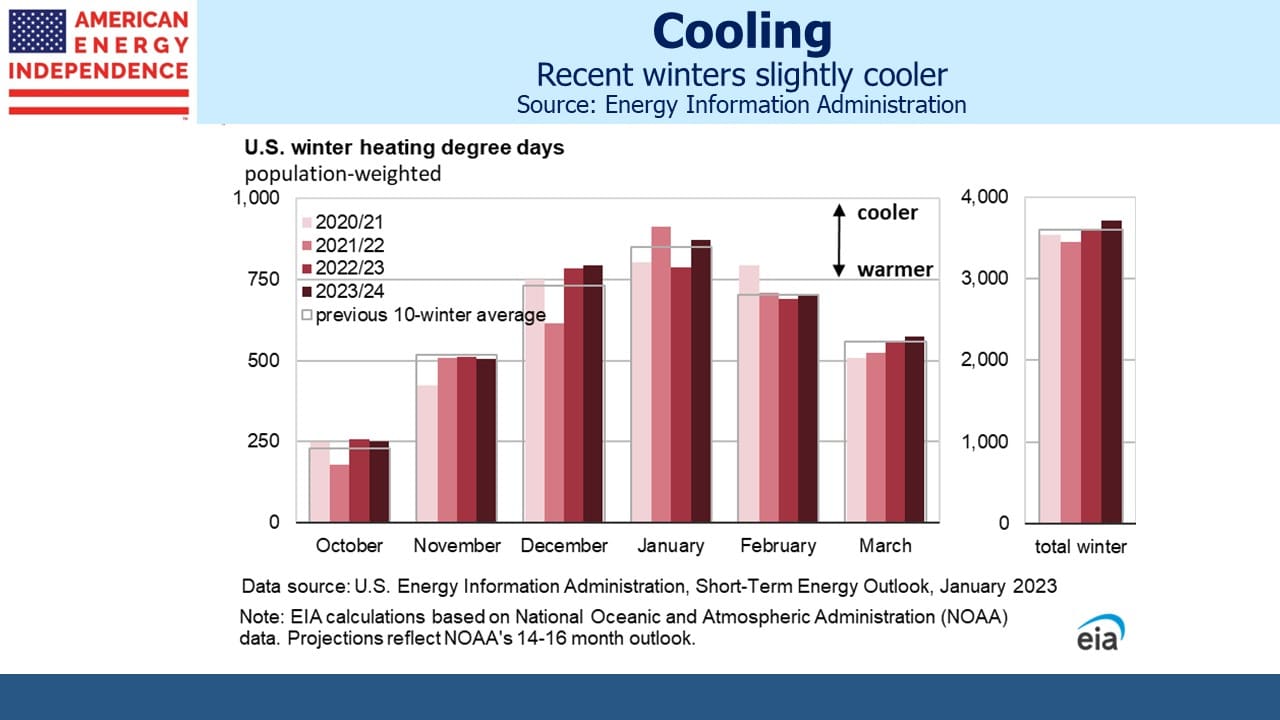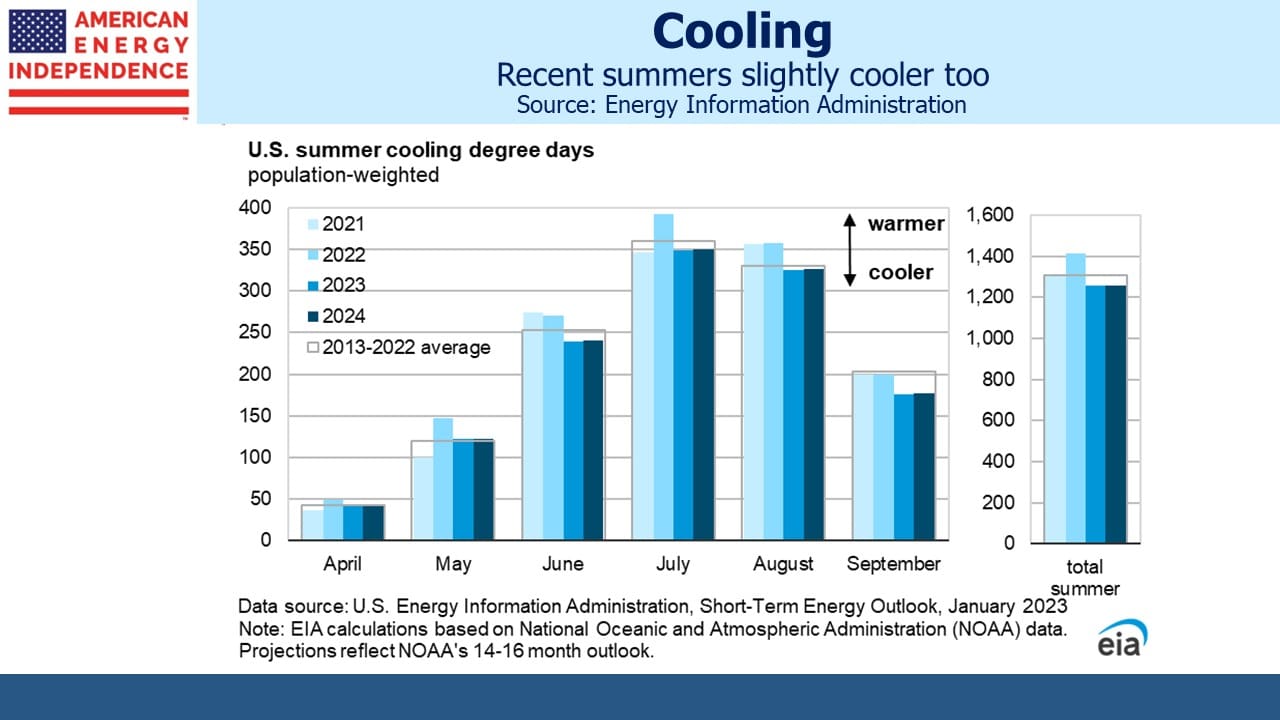US Oil And Gas Production Growing

/
The US Energy Information Administration (EIA) published their Short Term Energy Outlook last week. The EIA produces an enormous amount of data and is apolitical. For energy investors it’s really all good news.
US crude production is expected to grow, but slowly. Natural gas production will increase at a faster pace with export growth more than offsetting a modest drop in domestic consumption. US CO2 emissions will continue to fall, accommodating growth in China and other emerging economies where higher living standards are their priority.
The charts tell their own story. You’ll note that Residential and Commercial consumption of natural gas is expected to rise in spite of the musings of the Consumer Product Safety Commission about eliminating gas stoves. And the last four years have shown slightly cooler weather in the US, although not enough to form a trend.
Climate Action Tracker, a website that assesses countries’ commitments to reduce emissions, rates China “Highly Insufficient”. No country is compatible with the UN’s “Zero By 50” goal which requires eliminating CO2 emissions by that date in order to limit global warming to 1.5°C above 1850. Britain and Norway are among those rated “Almost Sufficient”. The US is “Insufficient” while China, India and most of Asia ex-Japan are rated “Highly Insufficient”.
China’s emissions are expected to grow through 2030, at which time the government says they’ll start falling and reach zero by 2060. Western negotiators at the UN who are dominated by liberal politicians too readily accept China’s word. They haven’t been forthcoming about Covid or much else, so it’s unclear why climate change would be different. Rich world countries, where climate concern is greatest, will push ahead with emissions-reducing policies that are more than offset by developing Asia. This gets too little media coverage.
Last week in a significant development, Climeworks announced that they had pulled CO2 from the air and stored it underground at a meaningful scale, verified by an independent third party. Direct Air Capture (DAC) is not easy – there’s around 412 parts per million of CO2 in ambient air, although it has been trending up. Much higher concentrations can be found in the emissions of power plants or petrochemical facilities. Although cheaper to capture at the source, the CO2 then needs to be moved by pipeline to permanent storage underground. Climeworks equipment can be built on or near the porous rock formations appropriate for permanent storage.
This development is another step towards proof of concept. Microsoft, e-commerce company Shopify Inc. and payments firm Stripe Inc have each agreed to pay hundreds of dollars per Metric Tonne (MT) for credits which they can use to offset their own emissions. Because the CO2 is permanently stored and independently verified, this is a more robust and honest way for companies to demonstrate reduced emissions.
The Inflation Reduction Act provides for 45Q tax credits as high as $180 per MT for DAC, a level that is generating interest among several US energy companies. We’ve been following carbon capture developments for some time (see Clean Energy Isn’t Just About Renewables). Occidental is developing the world’s biggest DAC facility driven in part by the 45Q credits (see How Occidental Invests In Lower Taxes).
Concrete maker Lehigh Hanson, plans to capture CO2 from its operations. Start-up CarbonCapture expects to remove 5 million MTs per annum by 2030, and UK-based DRAX 12 million MTs. The 45Q tax credits aren’t capped. The Congressional Budget Office estimated they’ll cost $3BN over the next decade. Credit Suisse thinks $52BN. Forecasts are that around 200 million MTs, representing 4% of US energy-related CO2 emissions, will be captured by 2030.
It’s also possible for carbon atoms to make a virtuous roundtrip. They first leave a natural gas formation as methane (CH4) to be used by a petrochemical facility before being emitted and returned as CO2 for sequestration back in a geological formation similar to the one they left (see Putting Carbon Back In The Ground).
It’s appealing to think that DAC could ultimately solve the problem of climate change. If the technology works, the world only needs to identify enough sites to deploy the Climeworks equipment for permanent CO2 sequestration. It’s much more appealing than relying on vast, intermittent solar and wind farms with requisite battery backup.
But Climeworks understands their market, and their website sensibly positions the company as complimenting other efforts to reduce emissions: “To mitigate climate change, we need all solutions to be working together. One measure alone is not enough.”
When the EIA’s outlook is combined with the positive fundamentals outlined in Wednesday’s blog post (see Bearishness Is Holding Back Energy), there are plenty of reasons for pipeline investors to remain optimistic.
We have three funds that seek to profit from this environment:

Important Disclosures
The information provided is for informational purposes only and investors should determine for themselves whether a particular service, security or product is suitable for their investment needs. The information contained herein is not complete, may not be current, is subject to change, and is subject to, and qualified in its entirety by, the more complete disclosures, risk factors and other terms that are contained in the disclosure, prospectus, and offering. Certain information herein has been obtained from third party sources and, although believed to be reliable, has not been independently verified and its accuracy or completeness cannot be guaranteed. No representation is made with respect to the accuracy, completeness or timeliness of this information. Nothing provided on this site constitutes tax advice. Individuals should seek the advice of their own tax advisor for specific information regarding tax consequences of investments. Investments in securities entail risk and are not suitable for all investors. This site is not a recommendation nor an offer to sell (or solicitation of an offer to buy) securities in the United States or in any other jurisdiction.
References to indexes and benchmarks are hypothetical illustrations of aggregate returns and do not reflect the performance of any actual investment. Investors cannot invest in an index and do not reflect the deduction of the advisor’s fees or other trading expenses. There can be no assurance that current investments will be profitable. Actual realized returns will depend on, among other factors, the value of assets and market conditions at the time of disposition, any related transaction costs, and the timing of the purchase. Indexes and benchmarks may not directly correlate or only partially relate to portfolios managed by SL Advisors as they have different underlying investments and may use different strategies or have different objectives than portfolios managed by SL Advisors (e.g. The Alerian index is a group MLP securities in the oil and gas industries. Portfolios may not include the same investments that are included in the Alerian Index. The S & P Index does not directly relate to investment strategies managed by SL Advisers.)
This site may contain forward-looking statements relating to the objectives, opportunities, and the future performance of the U.S. market generally. Forward-looking statements may be identified by the use of such words as; “believe,” “expect,” “anticipate,” “should,” “planned,” “estimated,” “potential” and other similar terms. Examples of forward-looking statements include, but are not limited to, estimates with respect to financial condition, results of operations, and success or lack of success of any particular investment strategy. All are subject to various factors, including, but not limited to general and local economic conditions, changing levels of competition within certain industries and markets, changes in interest rates, changes in legislation or regulation, and other economic, competitive, governmental, regulatory and technological factors affecting a portfolio’s operations that could cause actual results to differ materially from projected results. Such statements are forward-looking in nature and involves a number of known and unknown risks, uncertainties and other factors, and accordingly, actual results may differ materially from those reflected or contemplated in such forward-looking statements. Prospective investors are cautioned not to place undue reliance on any forward-looking statements or examples. None of SL Advisors LLC or any of its affiliates or principals nor any other individual or entity assumes any obligation to update any forward-looking statements as a result of new information, subsequent events or any other circumstances. All statements made herein speak only as of the date that they were made. r
Certain hyperlinks or referenced websites on the Site, if any, are for your convenience and forward you to third parties’ websites, which generally are recognized by their top level domain name. Any descriptions of, references to, or links to other products, publications or services does not constitute an endorsement, authorization, sponsorship by or affiliation with SL Advisors LLC with respect to any linked site or its sponsor, unless expressly stated by SL Advisors LLC. Any such information, products or sites have not necessarily been reviewed by SL Advisors LLC and are provided or maintained by third parties over whom SL Advisors LLC exercise no control. SL Advisors LLC expressly disclaim any responsibility for the content, the accuracy of the information, and/or quality of products or services provided by or advertised on these third-party sites.
All investment strategies have the potential for profit or loss. Different types of investments involve varying degrees of risk, and there can be no assurance that any specific investment will be suitable or profitable for a client’s investment portfolio.
Past performance of the American Energy Independence Index is not indicative of future returns.










Leave a Reply
Want to join the discussion?Feel free to contribute!